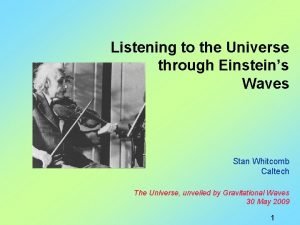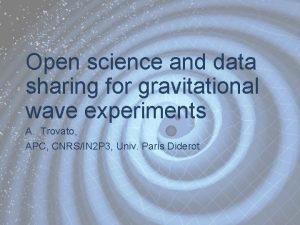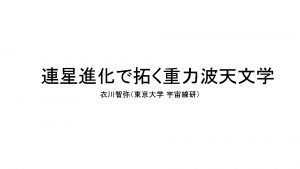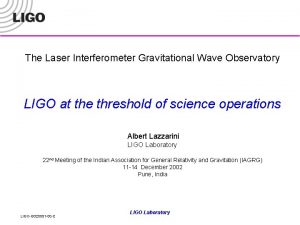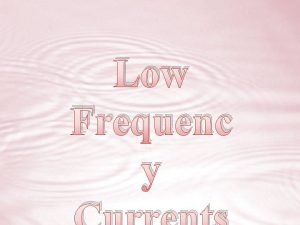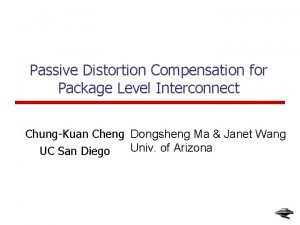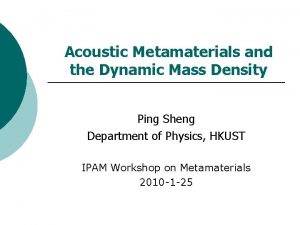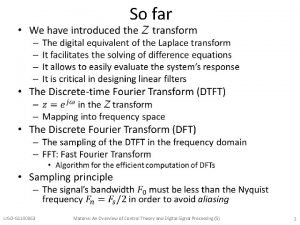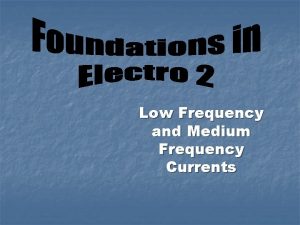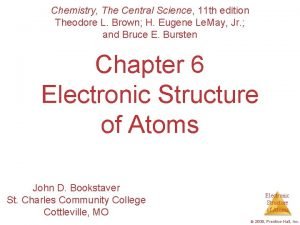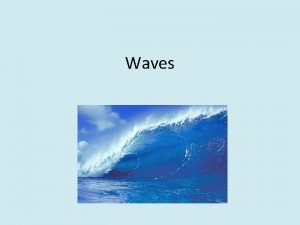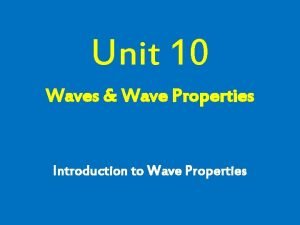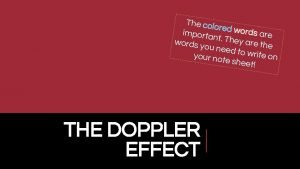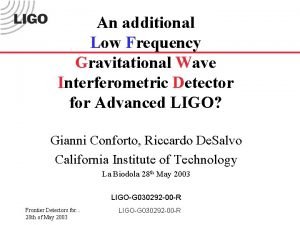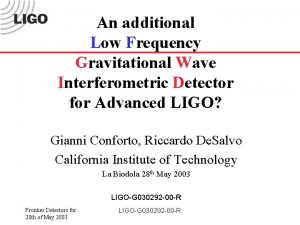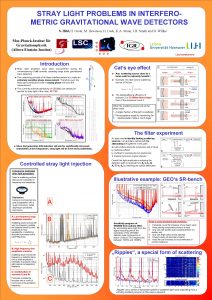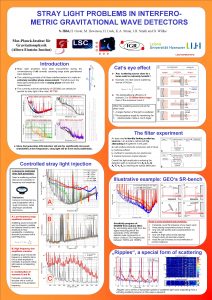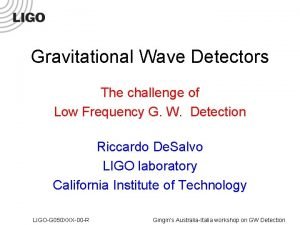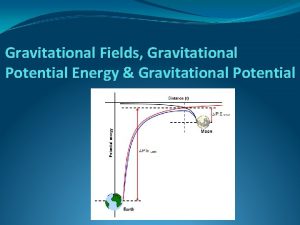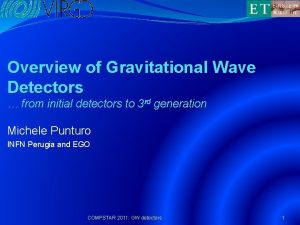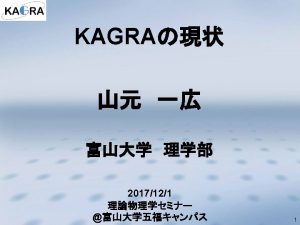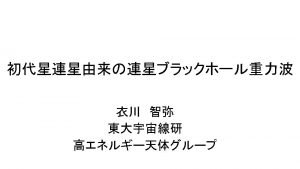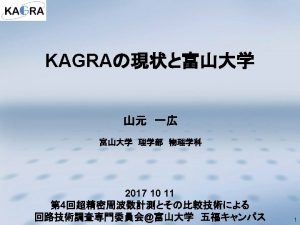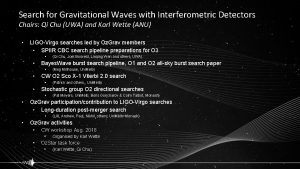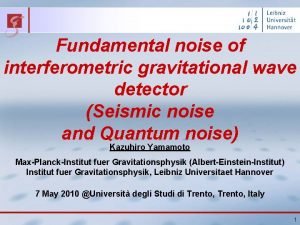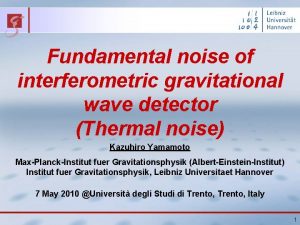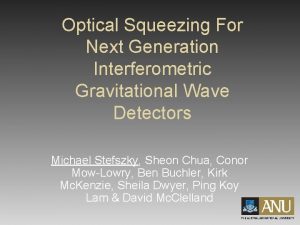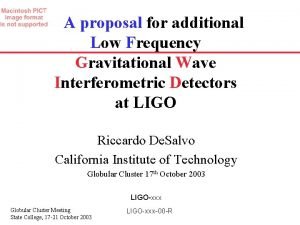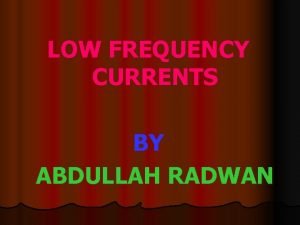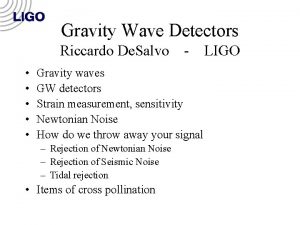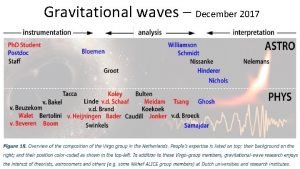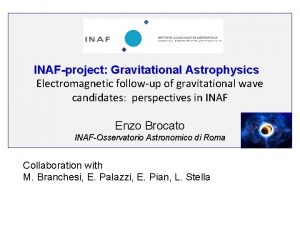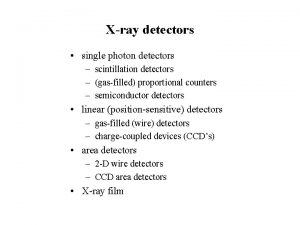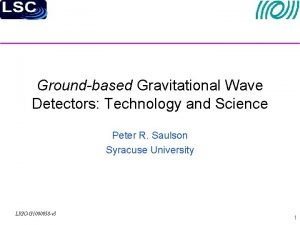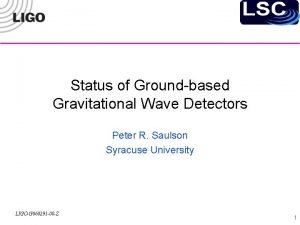Low Frequency Gravitational Wave Interferometric Detectors Riccardo De




















































- Slides: 52

Low Frequency Gravitational Wave Interferometric Detectors Riccardo De. Salvo GWADW 2002 Isola d’Elba 24 th of May 2002

Is it important to build a LF-GWID ? 2

Is it important to build a LF-GWID ? 3

Technical reason Narrowing canyons Any improvement of thermal noise narrows the sensitivity canyon In these specific conditions we can take advantage only of another or magnitude of thermal noise before the canyon closes 5

Shifting the canyons To efficiently cover a large frequency span it is necessary to build dedicated Interferometers each optimized at various frequency ranges 6

Reasons for a Low Frequency Gravitational Wave Interferometic Detector • Need to implement twin interferometers in the same vacuum enclosure • Complementary in frequency range • Separately cover the high and low frequency range • at LF not having power limitations, fused silica is probably better than sapphire 7

Comparing the canyon bottoms • Different. TN slope of • Sapphire Best at high frequency Also needed to dissipate high power • and • Fused Silica Best at low frequency 8

Kenji Numata Annealing seems to expose the plunge to zero dissipation at zero frequency 9

Let me cheat for a moment 1000 Hz Surface and Coating losses? Bottom of canyon? 100 Hz 10 -9 10 -10 10

Ingredients for LF-GWID • 1 • 2 Seismic Attenuation Control schemes • 3 • 4 Mirror suspensions (today’s focus) Mirrors – A – B • 5 OK OK Substrates Coatings Optical layout probably OK remains to be seen low power, will find solutions 11

Next prioriry towards a LF-GWID • The stumbling block for a • Low Frequency Gravitational Wave Interferometer is • Suspension Thermal Noise 12

This is the 1 st enemy This is the 2 nd enemy 13

3 Suspension thermal noise • Main Argument of presentation – Glassy metal flex joints – An alternative to fused silica at low frequency? 14

Suspension thermal noise • Cryogenics, a tough but in the long term almost sure bet • If we can reach the bottom of the valley at room temperature, why bother? • Is there an suspension alternative at room temperature and low frequency? • Glassy metal flex joints – Analyze metal vs. fused silica 15

Factor threeimprovement Factor of of three steel wires over steel wires reported for GEO by Norna Robertson. Progress limited by Intrinsic limitations intrinsic limitations 16

Alternative Suspension Solutions metallic flex joints • Metallic Flex joints have been evaluated in the past for mirror suspensions (D. Blair et al. ) • Metals start disadvantaged with respect with glasses because of lower intrinsic Q-factors (<10, 000 for metals). • Flex joint have an edge because they allow fabrication of ribbons with large aspect ratios => large pendulum dilution factors • Metals are stronger 17

Advantages of Glassy Metals • Like metals easy to shape and braze: allow advanced engineering and mechanical geometries. • Naturally produced in thin films or ribbons. • Not fragile (no water problem, thin ribbons) • • • 18

Si. O 2 +H 2 O scissor effect • Si. O 2 + H 2 O = 2 Si. O-OH • scissor effect 19

An additional advantage Glassy Metals • Like metals easy to shape and braze: allow advanced engineering and mechanical geometries. • Naturally produced in thin films or ribbons. • Not fragile (no water problem) • Allow loads of 4, 5 or even 6 GPa!!! • (Best steel limit at 1. 8 Gpa, typical fused silica 0. 7 GPa) • Very large elasticity limit (2%) • Some metallic glasses have low internal Q-factors but refractory metal glasses have large Q-factors 20

A pitfall Hydrogen flipping losses = Metal Atom = Hydrogen location Hydrogen atom flip-flop with changing stresses Also Q-factor is a steep function of ratio of melting/room temperature 21

Which Glassy Metals are promising • Glassy metals can be manufactured – Starting from many metals, recipe: – Mix two close relative metals – Molybdenum + Ruthenium – Add Boron to frustrate the formation of crystalline structures – Cool rapidly 22

Which Glassy Metals are promising • There is no qualitative difference between • Quartz / Fused Silica and • Crystalline metals/ Glassy metals • Crystallization time – Hours for Fused Silica – Seconds for Glassy Metals 23

Which Glassy Metals are promising • Molybdenum Ruthenium Boron do not absorb hydrogen and have very high melting points (similar or higher than Fused Silica) 24

Melting points 25

Which Glassy Metals are promising • In metallic glasses the Mo-Ru bond play same role as the Si-O bond in Fused Silica, both in determining the • melting temperature the • dissipation processes and the • damage processes 26

Why Glassy Metals are promising • Selected Glassy metals have high Q-factors • But intrinsic Q factor is less important because of the much more advantageous possible geometries 27

Estimated Mo. Ru. B glass properties • • Mo 49 Ru 33 B 18 in atomic percent. density, 9. 5 g/cc heat conductivity, 10 Watts/m-K heat capacitance, 30 J/mole-K linear thermal expansion coeff. , 5 -6 x 10 -6 (K-1) elastic modulus, 250 GPa Poisson modulus, 0. 36 -0. 38 breaking point 5 GPa (not fragile, loadable to > 4 GPa) • - These numbers should be accurate to +/- ~20% 28

Thermal noise of Mo. Ru. B flex joints Glassy metal Q=104, Fused Si. O 2 dumb bell shaped fiber Q=8. 4*108, 10*3000 = 30, 000 mm 2, 357 mm diameter, 100, 000 mm 2, 29 60 Kg mirror, 40 Kg mirror

What’s the development program • Make several samples of different compositions • Measure physical properties – – – Yield point, Elastic constant Poisson ratio Thermal capacity Thermal conductivity Thermal expansion coefficient. . . . • Measure reed (diving board) Q-factors of samples 30

What else to do • Demonstrate feasibility of fabrication of suspension structures • Demonstrate feasibility of attachments to mirrors without significant loss of mirror Q-factor • Test suspension Q-factors (>108) with macroscopic mirrors 31

What is being done? • Make several samples of different compositions • Samples are made in Caltech Metallurgy department (splat cooling) 32

R. F. levitation and What is being done? melting coil Pulsed Copper anvils 33

34

35

36

37

38

39

What does splat cooling produce? • The end product is a disk – 50 mm thick, – 15 mm in diameter • The surface copies the (electropolished) anvil’s surface to optical accuracy • Only 3*6 mm platelets are required 40

What is being done? • Measure physical properties – Yield point, – Elastic constant – Poisson ratio – Hysteresis – Thermal capacity – Thermal conductivity – diving board Q-factors 41

What is being done? 42

Measure reed Q-factors • Reed mounted on an isolation stack to isolate it from cryostat dissipation. • Optical lever readout of ringdown • Electrostatic excitation 43

Measure reed Q-factors Empty Cryo puck case, periscope housing Test reed on Q-factor probe on puck 44

What to be done next? • Need to Demonstrate feasibility • of employing Glassy Metals to fabricate • mirror suspensions with record Q-factor 45

What to be done next? • Ingredients – Suspension rigid structure carved by EDM – Glassy metal Flex joints brazed to the rigid structure – Flex joint structure brazed to a wire – Hook bonded to a ledge in the mirror 46

Fabricate the Flex Joint 16 mm • EDM carve half of the Flex Joint structure out of a single piece of material • The Flex Joint structure will be finished at the very end of the process by cutting the dashed lines • All the surfaces on which to braze the flex joint are aligned by birth! 47

Fabricating the Flex Joint thinning it from 50 to 10 mm by through-mask electrochemical micromachining (IBM patent) 50 mm 10 mm 50 mm • The Flex Joint Is positioned by a ”Cavalier”, with a slot to house thin part of flex joint 48

Fabricate the Flex Joint • The flex joint structure, is now provided with the glassy metal suspension wire • The thin flex joints, are still imprisoned by the cavaliers both are brazed together by the baking process • After brazing the ears of the cavaliers are EDM chopped off before separating the structure from its mother 49 plate

Fabricate the Flex Joint • The finished flex joint is finally ready for attachment to the mirror’s ledges 50

Fabricate the Flex Joint • The mating surfaces of the flex joint and of the mirror’s ledge are indium coated to provide an excess-noise-free connection 51

Why using ledges • The use of ledges and low temperature brazing eliminated all shear efforts • Can be assembled and disassembled by simply warming up the indium • Need to Demonstrate feasibility of attachments to mirrors without significant loss of mirror Q-factor 52

What is being done? 500 Kg mass Supporting 10 Kg mirror Observe pitch mode 53
 Giant gravitational wave detectors hear murmurs
Giant gravitational wave detectors hear murmurs Giant wave detectors murmurs universe
Giant wave detectors murmurs universe Giant wave hear murmurs across universe
Giant wave hear murmurs across universe Gravitational wave open science center
Gravitational wave open science center Gravitational wave
Gravitational wave Gravitational wave
Gravitational wave Photo detectors
Photo detectors Adsorption chromatography
Adsorption chromatography Feature detectors
Feature detectors Streaming current
Streaming current Where are feature detectors located
Where are feature detectors located Frontier detectors for frontier physics
Frontier detectors for frontier physics Photo detectors
Photo detectors Vhv voltage detectors
Vhv voltage detectors Feature detectors ap psychology
Feature detectors ap psychology Yodsawalai chodpathumwan
Yodsawalai chodpathumwan Nuclear detectors
Nuclear detectors Rhmd: evasion-resilient hardware malware detectors
Rhmd: evasion-resilient hardware malware detectors Low voltage = low hazard
Low voltage = low hazard Mid low high
Mid low high Low dominance and low sociability
Low dominance and low sociability Low accuracy low precision
Low accuracy low precision Low frequency currents
Low frequency currents Low frequency attenuation
Low frequency attenuation Low frequency current in physiotherapy
Low frequency current in physiotherapy Low frequency attenuation
Low frequency attenuation Example of mechanical wave
Example of mechanical wave Ligog
Ligog Medium frequency current
Medium frequency current Low frequency algorithmic trading
Low frequency algorithmic trading Images of gamma rays
Images of gamma rays Vmax = aw
Vmax = aw Frequency vs relative frequency
Frequency vs relative frequency Relative frequency bar chart
Relative frequency bar chart Observed frequency
Observed frequency Marginal frequency distribution
Marginal frequency distribution Peak factor formula
Peak factor formula Relative frequency table
Relative frequency table Waves are rhythmic disturbances that carry
Waves are rhythmic disturbances that carry Which wave has the highest frequency?
Which wave has the highest frequency? How to calculate frequency of a wave
How to calculate frequency of a wave Em spectrum frequency
Em spectrum frequency Which wave has the highest frequency?
Which wave has the highest frequency? Which wave has the lowest frequency
Which wave has the lowest frequency Mechanical wave and electromagnetic wave
Mechanical wave and electromagnetic wave Full wave rectifier vs half wave rectifier
Full wave rectifier vs half wave rectifier Longitudinal wave
Longitudinal wave Long waves and short waves
Long waves and short waves Examples of mechanical wave
Examples of mechanical wave Center tapped full wave rectifier
Center tapped full wave rectifier The wave chapter 10
The wave chapter 10 Difference between full wave and half wave rectifier
Difference between full wave and half wave rectifier Wavelength formula triangle
Wavelength formula triangle


